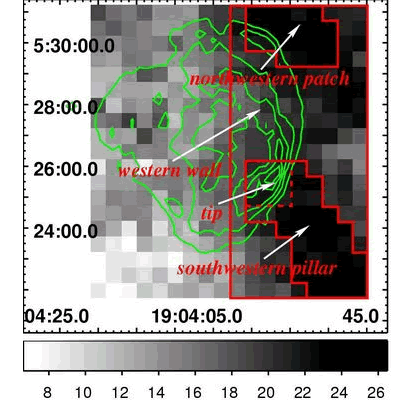
Dr. Su Yang, Purple Mountain Observatory, Chinese Academy of Sciences, present the results of the interaction between supernova remnant (SNR) 3C 396 and molecular clouds (MCs) using 13.7m millimeter-wavelength telescope at Delingha.
We have investigated the molecular environment of the semicircular composite supernova remnant (SNR) 3C 396 and performed a Chandra spatially resolved thermal X-ray spectroscopic study of this young SNR. With our CO millimeter observations, we find that the molecular clouds (MCs) at VLSR ∼ 84 km s−1 can better explain the multiwavelength properties of the remnant than the VLSR = 67–72 km s−1 MCs that are suggested by Lee et al. At around 84 km s−1, the western boundary of the SNR is perfectly confined by the western molecular wall.
The CO emission fades out from west to east, indicating that the eastern region is of lowgas density. In particular, an intruding finger/pillar-like MC, which may be shocked at the tip, can well explain the X-ray and radio enhancement in the southwest and some infrared filaments there. The SNR–MC interaction is also favored by the relatively elevated 12CO J = 2–1/J = 1–0 line ratios in the southwestern “pillar tip” and the molecular patch on the northwestern boundary.
The redshifted 12CO (J = 1–0 and J = 2–1) wings (86–90 km s−1) of an eastern 81 km s−1 molecular patch may be the kinematic evidence for shock–MC interaction. We suggest that the 69 km s−1 MCs are in the foreground based on Hi self-absorption while the 84 km s−1 MCs at a distance of 6.2 kpc (the tangent point) are in physical contact with SNR 3C 396.
The X-ray spectral analysis suggests an SNR age of ∼3 kyr. The metal enrichment of the X-ray emitting gas in the north and south implies a 13–15M B1–B2 progenitor star. Key words: ISM: individual objects (3C 396 G39.2−0.3) – ISM: molecules – ISM: supernova remnants Online-only material: color figures. |
